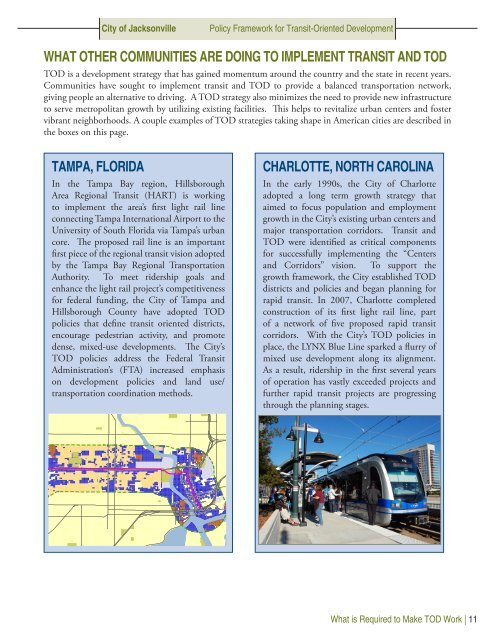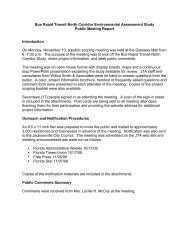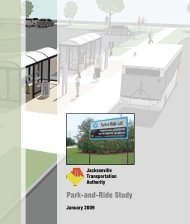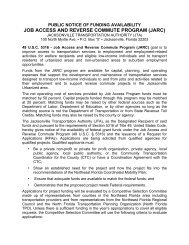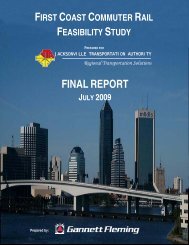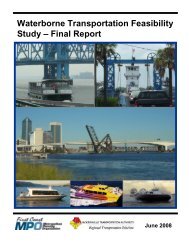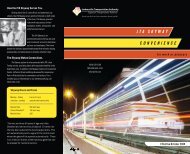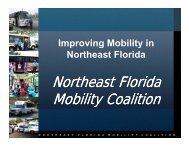Policy Framework - Jacksonville Transportation Authority
Policy Framework - Jacksonville Transportation Authority
Policy Framework - Jacksonville Transportation Authority
Create successful ePaper yourself
Turn your PDF publications into a flip-book with our unique Google optimized e-Paper software.
City of <strong>Jacksonville</strong><br />
<strong>Policy</strong> <strong>Framework</strong> for Transit-Oriented Development<br />
What Other Communities Are Doing to Implement Transit and TOD<br />
TOD is a development strategy that has gained momentum around the country and the state in recent years.<br />
Communities have sought to implement transit and TOD to provide a balanced transportation network,<br />
giving people an alternative to driving. A TOD strategy also minimizes the need to provide new infrastructure<br />
to serve metropolitan growth by utilizing existing facilities. This helps to revitalize urban centers and foster<br />
vibrant neighborhoods. A couple examples of TOD strategies taking shape in American cities are described in<br />
the boxes on this page.<br />
iles<br />
Tampa, Florida<br />
In the Tampa Bay region, Hillsborough<br />
Area Regional Transit (HART) is working<br />
to implement the area’s first light rail line<br />
connecting Tampa International Airport to the<br />
University of South Florida via Tampa’s urban<br />
core. The proposed rail line is an important<br />
first piece of the regional transit vision adopted<br />
by the Tampa Bay Regional <strong>Transportation</strong><br />
<strong>Authority</strong>. To meet ridership goals and<br />
enhance the light rail project’s competitiveness<br />
for federal funding, the City of Tampa and<br />
Hillsborough County have adopted TOD<br />
policies that define transit oriented districts,<br />
encourage pedestrian activity, and promote<br />
dense, mixed-use developments. The City’s<br />
TOD policies address the Federal Transit<br />
Administration’s (FTA) increased emphasis<br />
on development policies and land use/<br />
transportation coordination methods.<br />
Charlotte, North Carolina<br />
In the early 1990s, the City of Charlotte<br />
adopted a long term growth strategy that<br />
aimed to focus population and employment<br />
growth in the City’s existing urban centers and<br />
major transportation corridors. Transit and<br />
TOD were identified as critical components<br />
for successfully implementing the “Centers<br />
and Corridors” vision. To support the<br />
growth framework, the City established TOD<br />
districts and policies and began planning for<br />
rapid transit. In 2007, Charlotte completed<br />
construction of its first light rail line, part<br />
of a network of five proposed rapid transit<br />
corridors. With the City’s TOD policies in<br />
place, the LYNX Blue Line sparked a flurry of<br />
mixed use development along its alignment.<br />
As a result, ridership in the first several years<br />
of operation has vastly exceeded projects and<br />
further rapid transit projects are progressing<br />
through the planning stages.<br />
What is Required to Make TOD Work | 11


